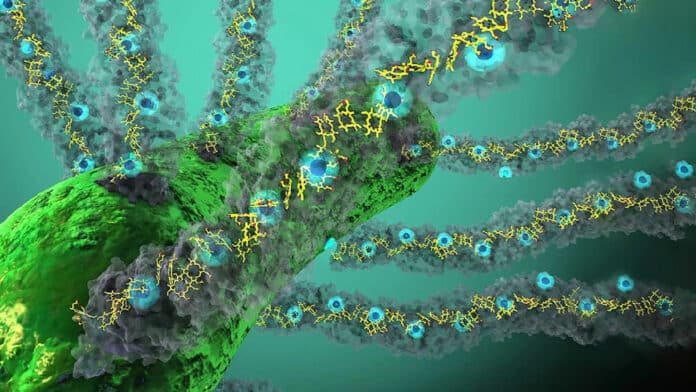The natural world has its own electrical grid, made up of a global web of tiny nanowires generated by bacteria in the soil and oceans that breathe by exhaling excess electrons.
In a new study, a team of researchers at Yale University discovered that light is a surprising ally in fostering this electronic activity within biofilm bacteria. Exposing bacteria-produced nanowires to light, they found, yielded up to a 100-fold increase in electrical conductivity.
Living cells have been incorporated with quantum dots and nanostructures for fluorescent labeling and drug delivery for over two decades. However, light-absorbing nanostructures have not been used to drive catalytic reactions inside cells due to a lack of biocompatibility and high cytotoxicity of foreign materials inside the cell, which often limits operational efficiency.
The result could provide new insights as scientists pursue ways to exploit this hidden electrical current for a variety of purposes, from eliminating biohazard waste to creating new renewable fuel sources. It is common for all living beings to breathe oxygen to get rid of excess electrons when converting nutrients into energy. Without access to oxygen, however, soil bacteria living deep under oceans or buried underground over billions of years have developed a way to respire by “breathing minerals,” like snorkeling, through tiny protein filaments called nanowires.
Researchers found that when these bacteria were exposed to light, the electric current was increased surprisingly. This is because most of the bacteria tested exist deep in the soil, far from the reach of light.
In the new study, a Yale team led by postdoctoral researcher Jens Neu and graduate student Catharine Shipps concluded that a metal-containing protein known as cytochrome OMCs – which makes up bacterial nanowires – acts as a natural photoconductor. The nanowires greatly facilitate electron transfer when biofilms are exposed to light.
“It is a completely different form of photosynthesis,” said senior author Nikhil Malvankar. “Here, light is accelerating breathing by bacteria due to rapid electron transfer between nanowires.”
The researchers are now exploring how this insight into bacterial electrical conductivity could be used to spur growth in optoelectronics and capture methane, a greenhouse gas known to be a significant contributor to global climate change.
Journal reference:
- Neu, J., Shipps, C.C., Guberman-Pfeffer, M.J. et al. Microbial biofilms as living photoconductors due to ultrafast electron transfer in cytochrome OmcS nanowires. Nat Commun 13, 5150 (2022). DOI: 10.1038/s41467-022-32659-5
